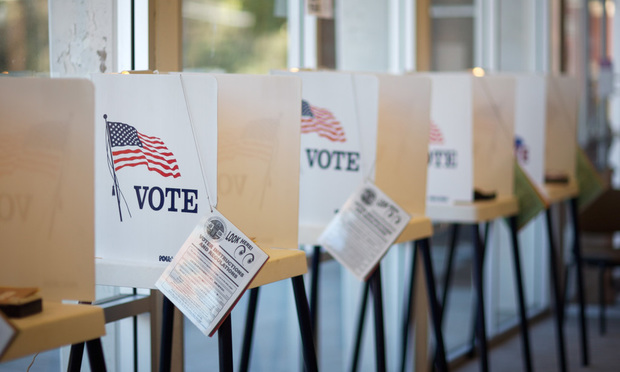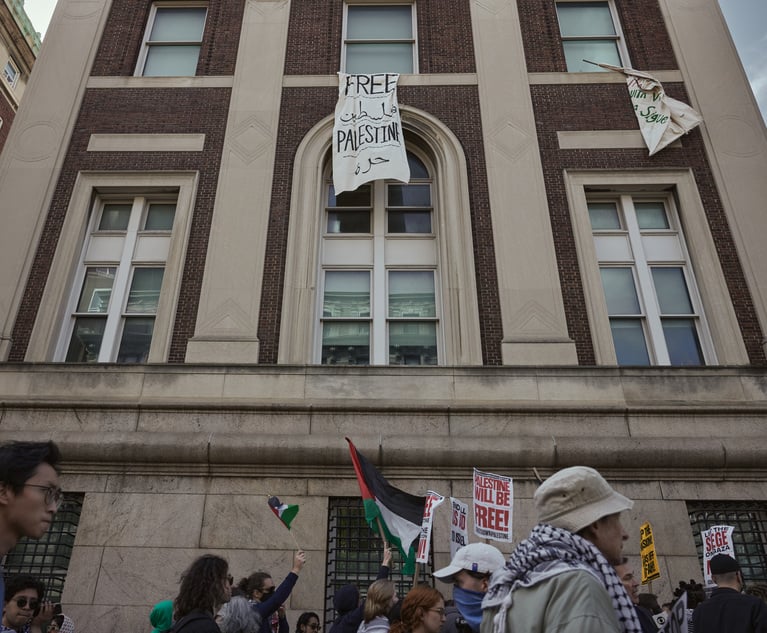17 Reasons Why the National Popular Vote Initiative Is Likely to Fail
Legal scholars have argued that NPV violates sections two and five of the 1965 Voting Rights Act and Equal Protection under the Fourteenth Amendment.
January 04, 2019 at 01:45 PM
6 minute read
 Jerry H. Goldfeder, in his December 17, 2018 letter, says it would be “a creative measure to have the winner of the popular vote actually be elected president.”
Jerry H. Goldfeder, in his December 17, 2018 letter, says it would be “a creative measure to have the winner of the popular vote actually be elected president.”
National Popular Vote envisages a compact, an agreement, among the states to cast their elector ballots for the national popular vote winner, regardless of how the people of their respective states voted. It would take effect when states with a majority of elector votes join NPV, 270 including the District of Columbia's three elector votes.
There are at least 17 reasons why NPV is unlikely to work.
- Only roughly half the states purport to bind electors to vote in accordance with their own state's popular vote. A state law that purports to bind its electors to vote even in accordance with its own popular vote, let alone the nation's, may be unconstitutional under Ray v. Blair.
- Could an NPV state elector force a colleague to vote in accordance with NPV? No elector voting enforcement mechanism is provided by NPV.
- Could an NPV state sue a withdrawing NPV state or its electors to vote in accordance with NPV? Where? When? How quickly?
A recent United States District Court decision rejecting New Jersey's attempt unilaterally to withdraw from a congressionally approved interstate compact with New York might imply that the first question above could be answered negatively. NPV has never been submitted to Congress for its approval.
- Under the Constitution, interstate compacts have to be approved by Congress. The United States Supreme Court held in United States Steel Corp. v. Multistate Tax Commission, that the Multistate Tax Compact did not need congressional approval because it did not increase the political power of the states who are parties by encroaching on that of the non-party states or by encroaching on federal supremacy. NPV increases the political power of states that are parties as opposed to states that are not by requiring the NPV states to cast their elector votes for the national popular vote winner regardless of how those states voted. Does NPV also encroach on the United States interest in presidential elections that conform to the intent of the framers and of the Twelfth Amendment? Professor Derek Muller has argued persuasively that NPV does so encroach.
- Congress is unlikely to approve NPV for the same reason that it would not likely approve a constitutional amendment substituting popular vote for the Electoral College.
- If a state's electors do not vote in accordance with NPV, will Congress count their votes?
On December 19, 2016, President Trump received 304 elector votes, Clinton 227, Colin Powell 3 (Clinton electors Washington) and one each for John Kasich (Trump elector Texas), Faith Spotted Eagle (Clinton elector Washington), Ron Paul (Trump elector Texas) and Bernie Sanders (Clinton elector Hawaii).
Since the mid-1840s, when the two party system became fairly firmly established, Congress has ALWAYS counted faithless electors votes, including in 1969 when the issue was extensively debated. Congress counted the 2016 faithless elector.
- NPV Article 4 says that any state may withdraw but only before the popular vote election. Because the Constitution gives each state legislature plenary power to determine how its electors are appointed, the power to withdraw probably cannot be limited.
- In a close election, the popular vote in many states may be disputed. What do NPV states electors do, if these disputes remain unresolved by the time in December they must meet to cast their ballots, as was true in Florida in 2000?
- The Twenty-Third Amendment gave the District of Columbia three elector votes. The legislative history is crystal clear that Congress did not intend the District to be considered a state for any purpose. Yet, the District joined NPV, and its elector votes are counted as part of the NPV majority.
- Any plurality is the NPV winning standard.
Most popular vote constitutional amendment proposals require a majority of the popular vote or, at the least, a substantial plurality. Lincoln's, Woodrow Wilson's and Clinton's were the lowest first term election percentages, Lincoln just under and the other two just over 40 percent, respectively, though each won comfortable elector vote majorities.
- Because the Constitution gives only state legislatures power to appoint electors, NPV's delegation to the winning popular vote candidate of a power to appoint electors under certain circumstances is almost certainly unconstitutional.
- Legal scholars have argued that NPV violates sections two and five of the 1965 Voting Rights Act and Equal Protection under the Fourteenth Amendment.
- Only eleven states have adopted NPV: California (55 elector votes); Connecticut (7); District of Columbia (3) (probably does not work, see supra paragraph 9); Hawaii (4); Illinois (20); Maryland (10); Massachusetts (11); New Jersey (14); New York (29); Rhode Island (3); Vermont (3) and Washington (12), a total of 171 elector votes, well short of an NPV majority of 268, or 270,even if DC is included.
All are blue states.
All, except Illinois, are East or West Coast states.
At least 24 mainly red states have not joined NPV and or not likely to do so for the same reasons that they want to keep the Electoral College. They have 236 electors, only 34 less than a majority.
- The eleven largest elector states, California (55), Florida (29), Georgia (16), Illinois (20), Michigan (16), New Jersey (14), New York (29), North Carolina (15), Ohio (18), Pennsylvania (20) and Texas (39) have 271 elector voters, a majority, but only five are NPV states. The 39 other smaller states, many of which are losing population, are not likely to cede their presidential fate to any big eleven.
- The Electoral College majority is not static, but NPV assumes that it is. The allocation of electors among the states changes, as it does if only as a result of the census every ten years. What if the NPV states no longer have an elector majority?
- Assume that to the existing NPV states are added new NPV states to constitute an elector majority. Further assume that President Trump runs for president as the Republican candidate in 2020, wins the popular vote but not an elector majority. How likely is it that electors in the current NPV states, like California and New York, all of which probably would have voted for the Democratic Party candidate, would as required by NPV, actually cast their elector votes for President Trump?
- Why add yet another layer of uncertainty to a situation that already is sufficiently uncertain?
A version of this completely footnoted appears on the Social Science Research Network link https://papers.ssrn.com/sol3/papers.cfm?abstract_id=3195747.
William Josephson is a retired partner from Fried, Frank, Harris, Shriver & Jacobson.
This content has been archived. It is available through our partners, LexisNexis® and Bloomberg Law.
To view this content, please continue to their sites.
Not a Lexis Subscriber?
Subscribe Now
Not a Bloomberg Law Subscriber?
Subscribe Now
NOT FOR REPRINT
© 2025 ALM Global, LLC, All Rights Reserved. Request academic re-use from www.copyright.com. All other uses, submit a request to [email protected]. For more information visit Asset & Logo Licensing.
You Might Like
View All
Attorney Responds to Outten & Golden Managing Partner's Letter on Dropped Client
3 minute read
Letter to the Editor: Law Journal Used Misleading Photo for Article on Election Observers
1 minute read
NYC's Administrative Court's to Publish Some Rulings in the New York Law Journal Is Welcomed. But It Should Go Further
4 minute readTrending Stories
- 1Data Disposition—Conquering the Seemingly Unscalable Mountain
- 2Who Are the Judges Assigned to Challenges to Trump’s Birthright Citizenship Order?
- 3Litigators of the Week: A Directed Verdict Win for Cisco in a West Texas Patent Case
- 4Litigator of the Week Runners-Up and Shout-Outs
- 5Womble Bond Becomes First Firm in UK to Roll Out AI Tool Firmwide
Who Got The Work
J. Brugh Lower of Gibbons has entered an appearance for industrial equipment supplier Devco Corporation in a pending trademark infringement lawsuit. The suit, accusing the defendant of selling knock-off Graco products, was filed Dec. 18 in New Jersey District Court by Rivkin Radler on behalf of Graco Inc. and Graco Minnesota. The case, assigned to U.S. District Judge Zahid N. Quraishi, is 3:24-cv-11294, Graco Inc. et al v. Devco Corporation.
Who Got The Work
Rebecca Maller-Stein and Kent A. Yalowitz of Arnold & Porter Kaye Scholer have entered their appearances for Hanaco Venture Capital and its executives, Lior Prosor and David Frankel, in a pending securities lawsuit. The action, filed on Dec. 24 in New York Southern District Court by Zell, Aron & Co. on behalf of Goldeneye Advisors, accuses the defendants of negligently and fraudulently managing the plaintiff's $1 million investment. The case, assigned to U.S. District Judge Vernon S. Broderick, is 1:24-cv-09918, Goldeneye Advisors, LLC v. Hanaco Venture Capital, Ltd. et al.
Who Got The Work
Attorneys from A&O Shearman has stepped in as defense counsel for Toronto-Dominion Bank and other defendants in a pending securities class action. The suit, filed Dec. 11 in New York Southern District Court by Bleichmar Fonti & Auld, accuses the defendants of concealing the bank's 'pervasive' deficiencies in regards to its compliance with the Bank Secrecy Act and the quality of its anti-money laundering controls. The case, assigned to U.S. District Judge Arun Subramanian, is 1:24-cv-09445, Gonzalez v. The Toronto-Dominion Bank et al.
Who Got The Work
Crown Castle International, a Pennsylvania company providing shared communications infrastructure, has turned to Luke D. Wolf of Gordon Rees Scully Mansukhani to fend off a pending breach-of-contract lawsuit. The court action, filed Nov. 25 in Michigan Eastern District Court by Hooper Hathaway PC on behalf of The Town Residences LLC, accuses Crown Castle of failing to transfer approximately $30,000 in utility payments from T-Mobile in breach of a roof-top lease and assignment agreement. The case, assigned to U.S. District Judge Susan K. Declercq, is 2:24-cv-13131, The Town Residences LLC v. T-Mobile US, Inc. et al.
Who Got The Work
Wilfred P. Coronato and Daniel M. Schwartz of McCarter & English have stepped in as defense counsel to Electrolux Home Products Inc. in a pending product liability lawsuit. The court action, filed Nov. 26 in New York Eastern District Court by Poulos Lopiccolo PC and Nagel Rice LLP on behalf of David Stern, alleges that the defendant's refrigerators’ drawers and shelving repeatedly break and fall apart within months after purchase. The case, assigned to U.S. District Judge Joan M. Azrack, is 2:24-cv-08204, Stern v. Electrolux Home Products, Inc.
Featured Firms
Law Offices of Gary Martin Hays & Associates, P.C.
(470) 294-1674
Law Offices of Mark E. Salomone
(857) 444-6468
Smith & Hassler
(713) 739-1250







